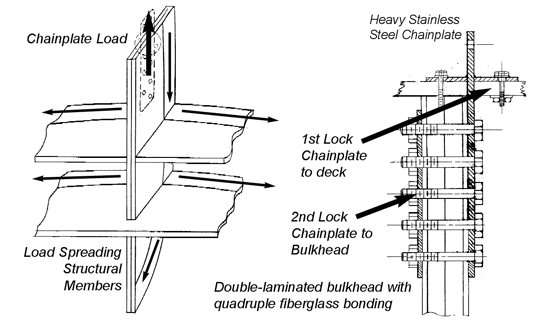|
DOUBLE-LOCK CHAINPLATE SYSTEM™--
HOW OUR CHAINPLATE SYSTEM SHARES A HEAVY
LOAD. |
|
When a boat is under sail, her stays and
shrouds are under tremendous tension. On many boats, the load on these
mast supports is carried by chainplates attached directly to the hull.
|
|
But there's much more to the chainplate system on a Caliber. We anchor
each chainplate with stainless hex bolts to a massive thick bulkhead,
which is thoroughly bonded to the hull over it’s entire height. We go to
all this trouble so that the load on the chainplates is dispersed
throughout the hull, not concentrated in small spots. And our Double-Lock
Chainplate System™ strengthens the deck to the hull connection, preventing
potential chainplate leaks. |
|
In addtion, we set our chainplates inboard on the deck, to allow tighter
sheeting of the genoa when close-hauled to windward, plus it makes it easier
fore and aft passage
along the deck. |
|
Double-Lock Chainplate
System™ |
|
 |
|
From “Offshore Yachts” by John Rousmaniere |
|
“The mast step must distribute mast compression fore and aft to floors.
A bulkhead close to the mast is a desirable feature. Chain-plate loads
should be spread by a hull attachment that is as longs as possible--a
structural bulkhead is ideal.” |
|
From “Further Offshore: A Practical Guide for Sailors” by Ed Mapes |
|
“The chainplates, port and starboard and on the stem and transom, should
be attached to solid structural members that distribute the rigging
loads to the vessel’s backbone without causing local distortions.
Ideally, for strength and redundancy, each stay and shroud should have
its own chainplate.” |
